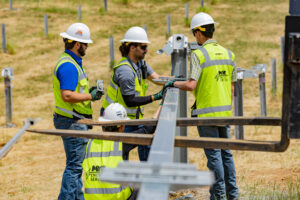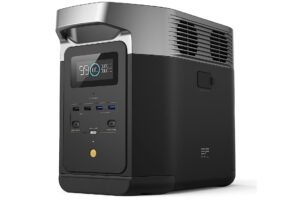Nevados opens new solar tracker production line at East Texas steel plant


A crew installs Nevados solar trackers on a job site. (Courtesy: Nevados)
Both companies expanding as solar spreads across tough Texas terrain
What does “America’s #1 Name in Ranch & Rodeo” have in common with an all-terrain solar tracking company?
A lot, it turns out.
In a modern twist on the “politics makes for strange bedfellows” adage, Nevados is opening a new solar tracker production line at the Priefert Steel plant in East Texas.

“We pursued the solar industry and found Nevados along the way,” explained Rocky Christenberry, vice president of manufacturing at Priefert Steel. “It was a perfect fit. We have like values.”
Priefert, which was founded in 1964 and invented the first front-opening cattle headgate, will manufacture Nevados’ all-terrain solar mounting and tracking equipment at its factory in Mount Pleasant, about two and a half hours East of Dallas. The Nevados tracking system allows solar panels to be set up on otherwise unusable terrain, eliminating the environmentally destructive practice of utility-scale grading.
“Instead of forcing the land to fit the solar installation by flattening it, we augment to fit the landscape,” said chief commercial officer of Nevados, Jenya Meydbray. “You can either throw bulldozers at it and move some dirt around or choose Nevados and avoid that altogether.”
Nevados’ tech can sustain the structural stress of inclement weather and high-wind environments, permitting solar development in formerly impractical areas, the company claims. Its most-capable bearing has a universal joint that can carry a fifteen-degree angle.
Meydbray theorizes the equipment can withstand sites that receive wind gusts of 135-140 miles per hour. “Beyond that, it starts getting pretty expensive,” he said. “But I don’t see any weather in the United States that would restrict us from operating there.”

In fact, according to Meydbray, some developers have opted to use Nevados’ system even in mostly-level areas simply because it was cheaper and easier to install.
Both companies are proud to use 100% U.S.-made steel parts, noting that an American supply chain can offer some predictability in times of uncertain global climate. “We are very much made in America,” smiled Christenberry. Keeping transportation costs limited to domestic shipping further reduces the partnership’s carbon footprint.
Nevados and Preifert Steel are both growing along with the renewables market in Texas, which recently toppled long-reigning California as the state with the most utility-scale solar power on its grid. The Electric Reliability Council of Texas, which operates most of Texas’ grid, had 18,364 MW of solar power capacity installed as of September 30, 2023, according to ERCOT data. That’s enough electricity to power about 3.7 million homes during peak demand. ERCOT expects to reach 37.26 GW of installed solar capacity in 2024 and more than 48 GW in 2025.
“We are in the hockey stick right now, doubling, tripling, five-exing year-over-year,” boasted Meydbray, who said Nevados will be contracted to supply roughly 1.5 GW in tracking equipment. “We don’t see that slowing down,” he added. “There’s no obvious ceiling to how much of the industry we can support with our product.”
Preifert started manufacturing equipment for other companies in 2008 during times of economic uncertainty. By 2017, that portion of the company had outgrown its classic rodeo business. Priefert Steel currently employs about 900 people, with more than 100 on solar projects, a number that continues to increase.
“Why do you want to grow? It’s like a tree, because I can,” chuckled Christenberry. “We are growing with solar right now. We might be growing with another industry in the next decade, but that’s where we’re at now.




